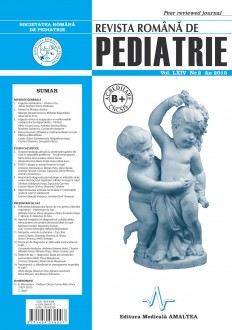SELECT ISSUE

Indexed

| |

|
|
|
| |
|
|
|

|
|
|
|
|
|
|
HIGHLIGHTS
National Awards “Science and Research”
NEW! RJP has announced the annually National Award for "Science and Research" for the best scientific articles published throughout the year in the official journal.
Read the Recommendations for the Conduct, Reporting, Editing, and Publication of Scholarly work in Medical Journals.
The published medical research literature is a global public good. Medical journal editors have a social responsibility to promote global health by publishing, whenever possible, research that furthers health worldwide.
CONTRIBUTION OF IMAGING EXAMINATIONS IN DIAGNOSIS OF INTRACRANIAL COMPLICATIONS IN CHILDREN OTOMASTOIDITIS
Mariana Coman, Alexandru Coman, Dan-Cristian Gheorghe and Mihaela Balgradean
ABSTRACT
Introduction. Otitis media (OM) is one of the most common infections in child pathology, most often with selflimited evolution (1,2). In 2-6% of cases (2) developed, intracranial complications with unfavorable, fatal outcome in 8-26.3% of them (2,3). Presence of neurological signs in the evolution of suppurative otitis require early imaging examinations (2-8).
Material and methods. We presents the case of a 10 year old girl with suppurative otitis complicated, transferred to the Clinical Emergency Hospital for Children „M.S. Curie“, Bucharest to ENT department after 2 weeks of disease progression. The child presents at hospital: fever, purulent otorrhea, neurological signs represented by headache, seizures, stiff neck. Contrast-enhanced computed tomographic (CT) were performed in emergency.
Result. CT scanning, extended to the neck show the presence of a lytic process in the temporal bone, solution of continuity between mastoid antrum and meninges with epidural abscess form over sigmoid sinus, trombophlebitis and thrombus of sigmoid sinus, which is propagate to the lateral sinus and the jugular vein; signs of meningitis, cerebellar cerebritis, brain temporal abscess and subdural empyema.
Conclusions. Complications in middle ear infections are rare, but the appearance of neurological signs in clinical examination must be completed by CT of head with contrast, which can specify local architecture, presence of local or distant complications, help in the application to a fast and appropriate therapy.
Keywords: child, otitis media, complications, computer tomography (CT)
